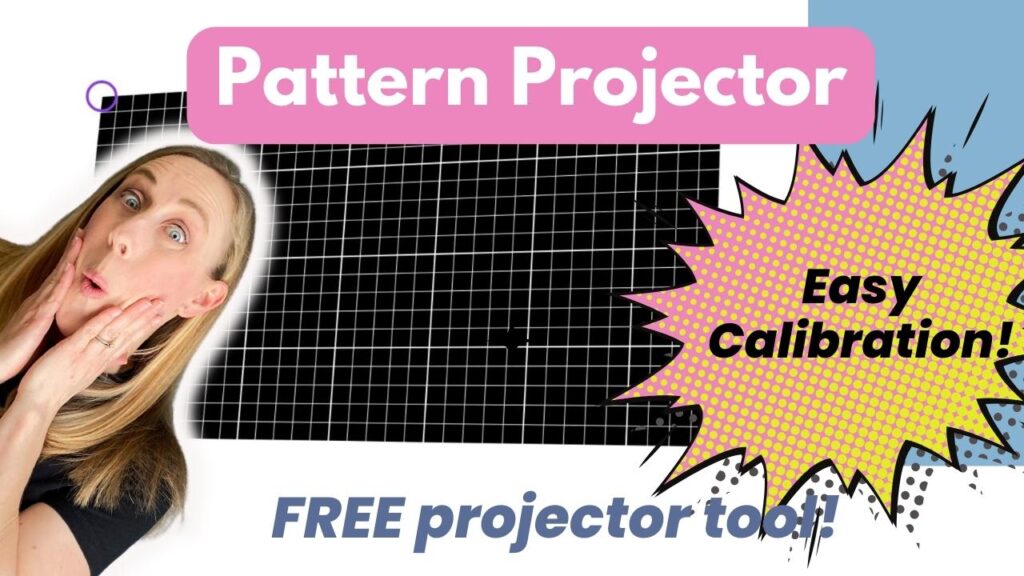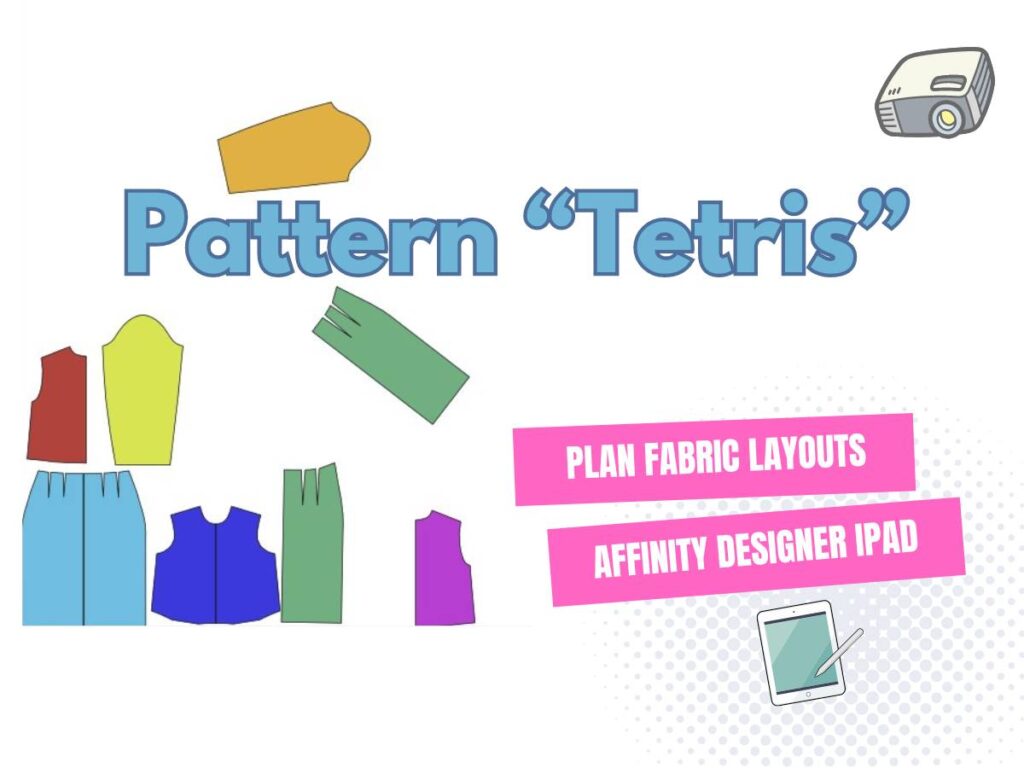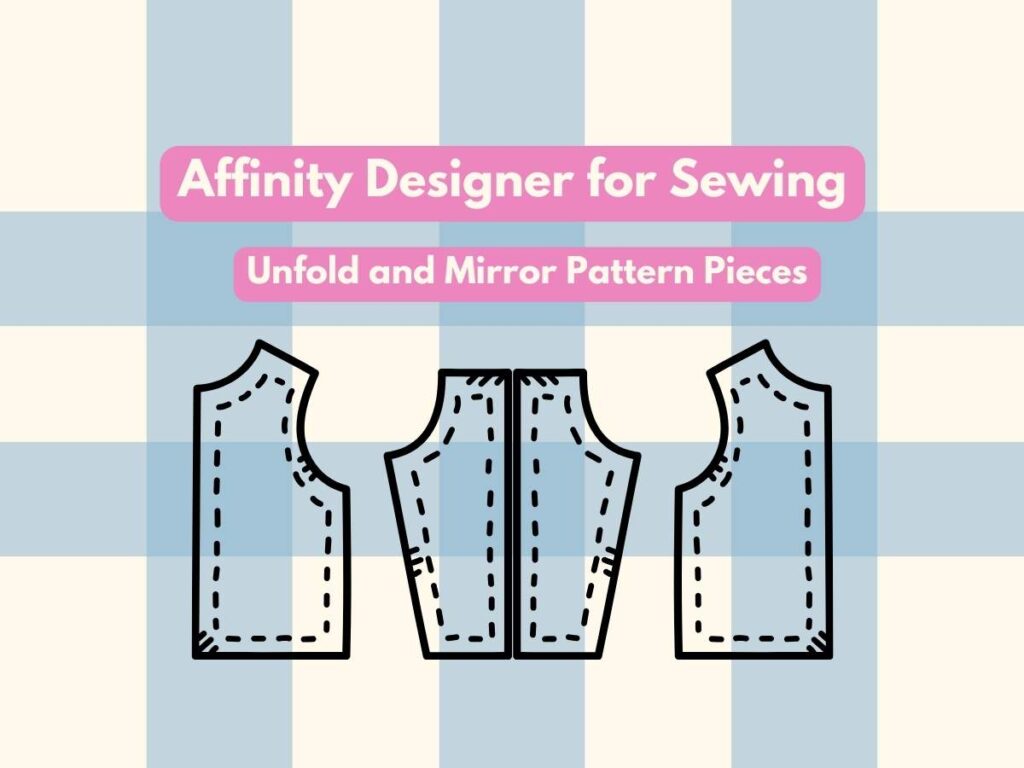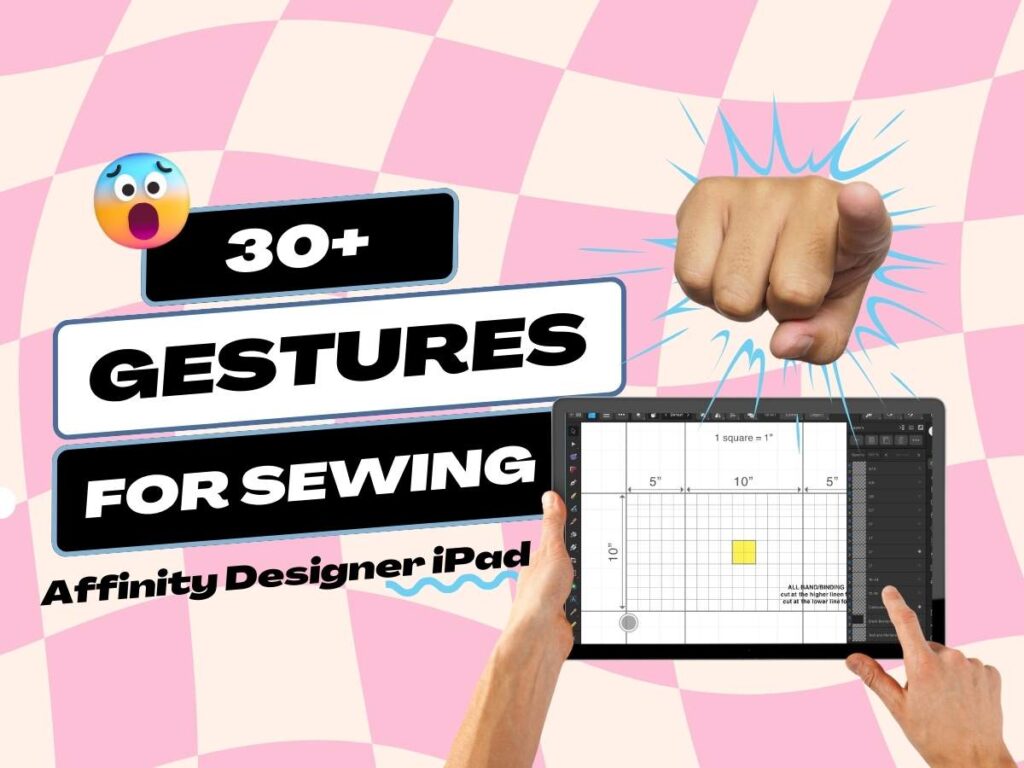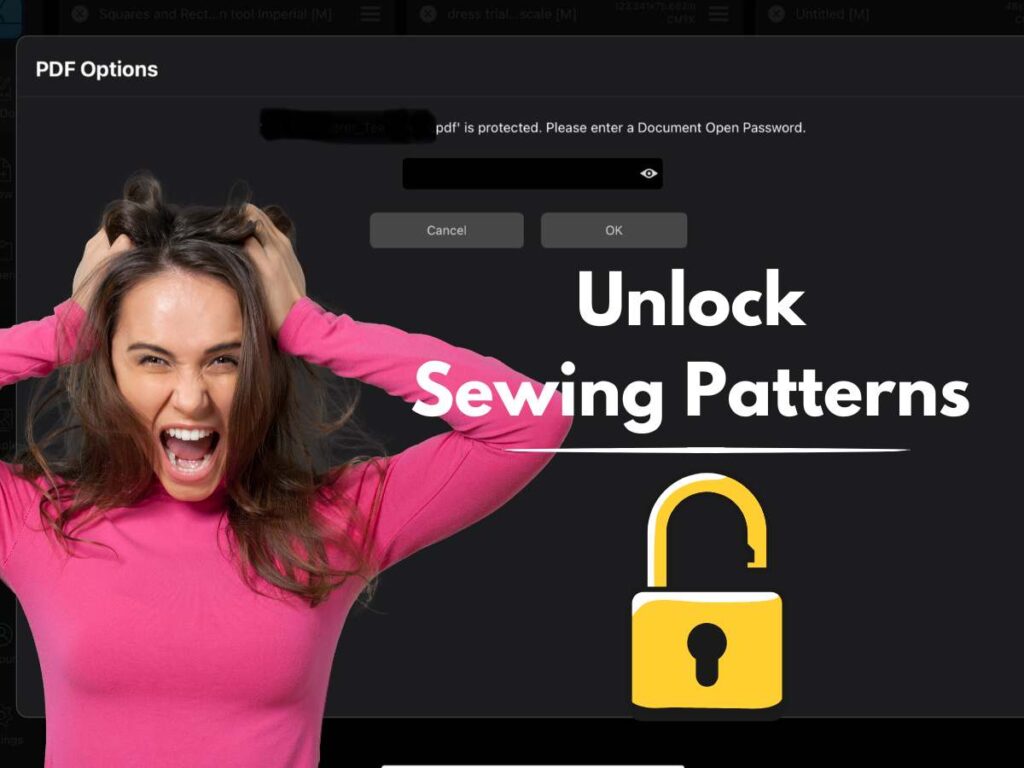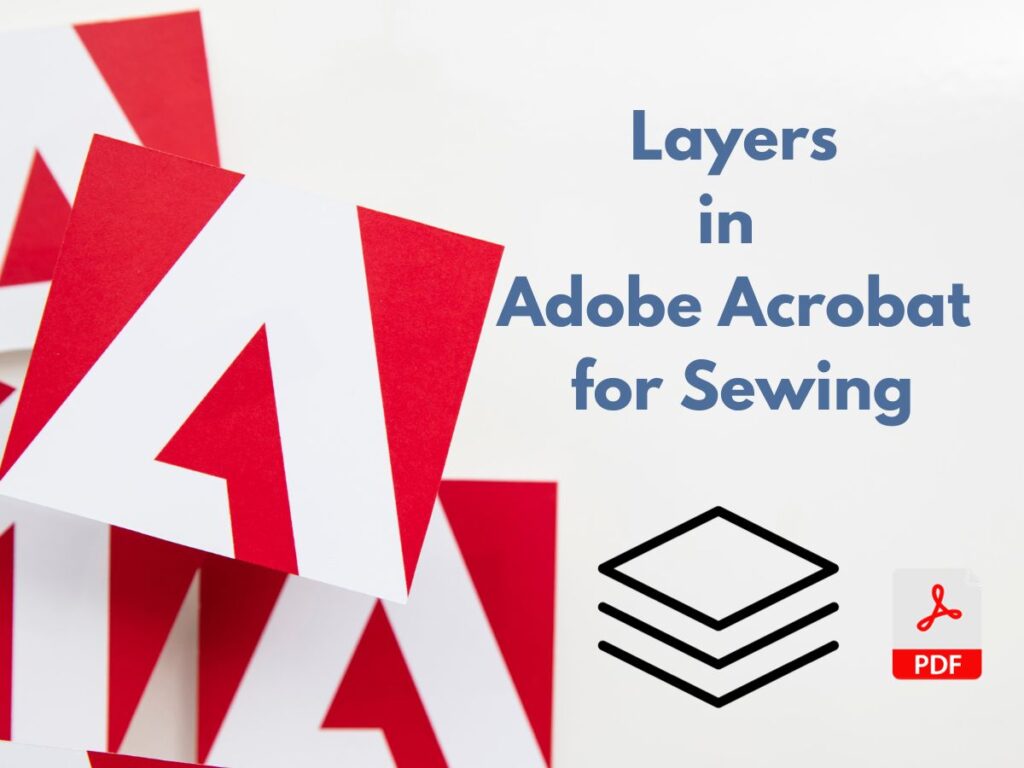Last updated on November 30th, 2023 at 10:39 pm
*This post may contain affiliate links and we may earn a small commission if you click on them.
Affinity Designer is a great program for sewing with projectors. The program can be used to unfold pieces, grade between sizes, lengthen and shorten patterns, and so much more. However, it can be daunting to try to learn a new software. So, whether you are just learning about Affinity Designer, or its been sitting on your computer unused for a while, this tutorial is for you!
Let’s dive into the basics of Affinity Designer for sewing to get you enhancing your projector patterns today!
Pre-requisite: Download Affinity Designer free trial or paid version.
Not sure about Affinity? Check out this article comparing Affinity Designer Vs. Inkscape for sewing to see which one might be better for you!
Objective: Learn to open, setup, and export a pattern in Affinity Designer. Become familiar with the basic tools and layers panel.
Let’s jump right in! To get the most out of this tutorial, open Affinity Designer and play with these settings along with me! You will get the hang of it in no time!
You can watch this as a video tutorial or read through the steps and pictures below! They cover the same information.
How to setup your Studio View
Before even opening a pattern, let’s start by organizing and setting up the studio view in Affinity Designer. Open up the program Affinity Designer. When you first open the program a startup panel will appear. You can uncheck the box at the bottom so this doesn’t pop up again. Just select “close” and it will take you to the main view.
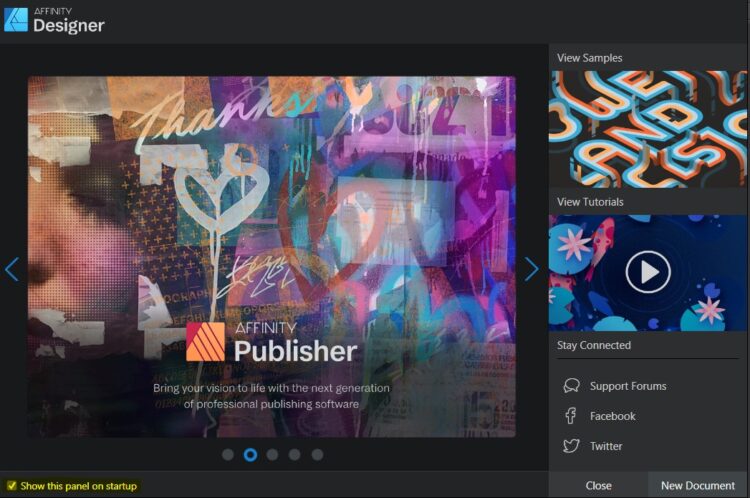
Now you may see some distracting “Studios” on the right and left. To change the settings for these go to View>Studio and uncheck left studio.
I prefer to leave the right studio on for layers, but you can turn it off if you need more space to view your pattern. You can also press CTRL + Shift + H to quickly hide the studio. Press it again and the studio will reappear!

Import a Pattern into Affinity Designer
Importing a pattern is very similar to how you might open a pattern in any other program. You will need the pattern saved on your computer or have the desktop link to Google Drive (or other cloud storage). To open a pattern in Affinity go to File>Open>(Find the pattern on your computer and click on it).
A popup will open asking about how to load the file. I keep checked load all pages, favor editable text, group lines of text, and replace missing fonts.
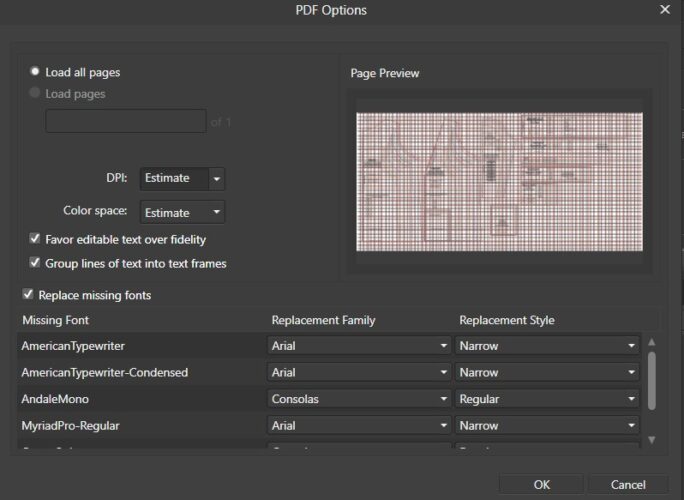
Customize Tools and Toolbar for Sewing Patterns
Next, we will learn to customize the tools and toolbar in Affinity Designer. You may not know what tools you like or don’t yet, but you can always modify later.
The toolbar is the options at the top of the artboard, below the menu. The most common actions on the toolbar you will use are the flip, rotate, and align actions.

View>customize toolbar This will allow you to customize what options appear on the top toolbar. View>Customize tools will allow you to rearrange, add, or delete any tools you want.
Document Setup and Adding Margins to Patterns in Affinity Designer
The document setup panel is a great place to setup the parameters of the document and add any scroll space around the pattern (often referred to as margins).
In the menu go to File>Document Setup. Once in the document setup panel, change the document units to your preferred unit of measurement (cm/in). There is a shortcut to changing the units that I will talk about in the rulers and grid section. The “Page Preset” should be custom. On the dimension you can “unlock” the ratio and enter any number for the size of document you want. You can guestimate how much extra space around the document you need. If it already has some space, you may only need to increase the dimensions a little. If no large margins are given, then you may want to increase the scroll roll perimeter by 20 inches.
Remember Adobe cannot open anything larger than 200×200 inches (1290 cm) though! Under “Objects Will” choose “Anchor to page”. You can always go back to document setup tab and change as needed.
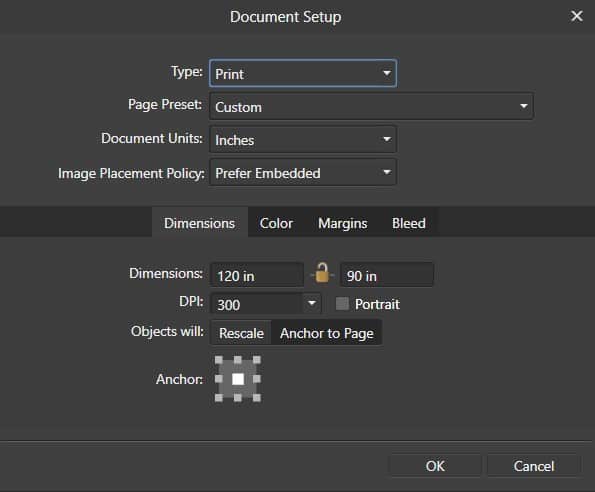
Grid/Ruler
The ruler around the artboard (Pattern) can be in view or removed. To make the ruler visible go to the menu View>show ruler (it will use the units from document setup). The shortcut for showing the ruler is CTRL (Cmd) + R . If the ruler is not in the units you prefer, then this can be changed in the document setup panel or by right clicking on the unit label in the top corner of the ruler. A popup will appear of all the options and you can choose which one you prefer!
You can also show a grid on your pattern for working by going to View>show grid. The keyboard shortcut is CTRL + ‘.
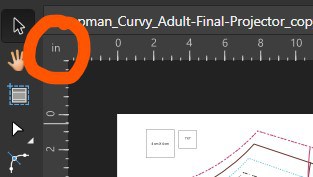
Zoom
Zoom is probably a feature you will use a lot as you modify patterns. There are many ways to control zoom in Affinity Designer. You can go to the menu View>Zoom and choose one of the options. The mouse and keyboard shortcut for zoom is to press CTRL and scroll roll on mouse up and down to zoom in and out. Or on just the keyboard press CTRL (Cmd) + = to zoom in and CTRL (Cmd) + – to zoom out.
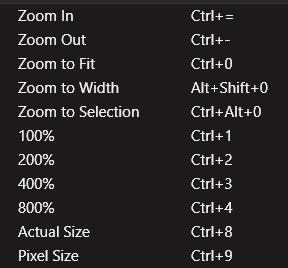
Layers Panel
The layers panel is great when working with sewing patterns. While you can create layers in sewing patterns without them, it is best if layers are already included in the pattern. A future tutorial will show you how to create layers for patterns without them.
A pattern’s layers all displayed in the layers tab. Most pattern companies will have them layered and labeled by size, especially if they are projector specific files. The arrows on the left of the layer name will expand and show you the lines and curves that are part of that layer.
When making changes to a size for grading, I like to duplicate the entire layer. You can do this by right clicking on the layer and choosing “Duplicate”. Click on the duplicated layer and name it anything you would like! This could be your name or the name of the person you are grading the pattern for.
The checkbox on the right will make a layer visible or not. Uncheck the box if you don’t want to see a layer. The layer will not be deleted and will still appear on the final export to Adobe when you check the box again before exporting.
Clicking on a line or object on the “artboard” will also highlight where the item is in the layers panel. Nifty feature if you are not sure what layer a line or object is in!
A new layer can be created by pressing CTRL + Alt + N. Click and drag and dop it to any new area you want. You can nest it inside another layer depending where you drag the mouse and what hierarchy is highlighted. You can also quickly add a new layer by clicking the icon at the bottom of the layer panel that looks like a piece of paper.
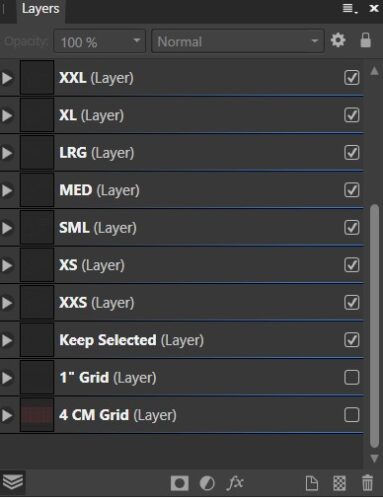
Duplicate and Flip Pattern Pieces in Affinity Designer for Sewing
Duplicate and flip are some of the most common actions that we use when modifying patterns for projector sewing. To duplicate an object select it.
*If the entire pattern piece is not selected, you may need to group pieces together first. To group pieces together, press Shift while clicking the individual pieces. Then press Ctrl (Cmd) + G. To ungroup press SHIFT + CTRL + G
Once the piece is duplicated, you can flip it. Flipping is a transform action. You can go to Layer>Tansform>Flip Horizontal (or Vertical) you can also rotate the piece. Or you can click the icon in the toolbar that looks like a triangle with the left blue (horizontal) or top blue (vertical).
Export as PDF for Projector Sewing
When you are done modifying your pattern, you want to make sure to export it as a PDF that can be opened in Adobe. Before exporting the pattern, make sure to select all the layers that you want to be exported to your PDF. Remember that the file cannot be larger than 200×200 inches (about 1290 cm). Go to File>Export and choose PDF. The shortcut is CRT+ALT+Shift+S.
I have exported as PDF (for Print) and PDF (for Export). As far as pattern projecting goes, I haven’t really noticed a difference between the two. You should now be able to open the pattern in Adobe. All the layers will be preserved and can be selected or deselected in the layers panel in Adobe.
What if a pattern is “locked”?
Sometimes you will come across a pattern that cannot be opened in Affinity Designer because it says it is “locked”. A quick run through PDF Stitcher (no need to change anything), will typically fix this. Run the pattern through PDF Stitcher and save it with a new name. Open the new file and it should open correctly.
On very rare occasions this doesn’t work either. Your other option is to try Sedja.
Commonly Used Keyboard Shortcuts
I have created the shortcut sheet above, but Affinity Designer also has these nifty keyboard shortcuts for Window, Mac, and iPad. Download the one you need!
Conclusion
How did it go? Did you follow along on your computer? You should feel a sense of accomplishment! You are on your way to mastering Affinity Designer for sewing. I’ve walked you through opening, setting up, and exporting patterns in Affinity Designer.
We’ve also explored some of the basic functions you will need to use including zoom, layers panel, duplicate, and flip.
Now go out and experiment more on patterns in using Affinity Designer for sewing. The more you practice the easier it will become! Don’t forget to tell your friends where you found this tutorial and share on social media!
Thanks!
Happy Sewing!

Affinity Designer Master Class
Learn to master Affinity Designer with the program that Sheredith from Projector Sewing started with!
“I highly recommend this course to anyone that is new to Affinity Designer! Although it is not sewing specific, this class is invaluable to getting started.” -Sheredith
This Logos By Nick master class contains 60+ explainer videos that go over every tool and feature of Affinity Designer.
Get lifetime access for only $17!


